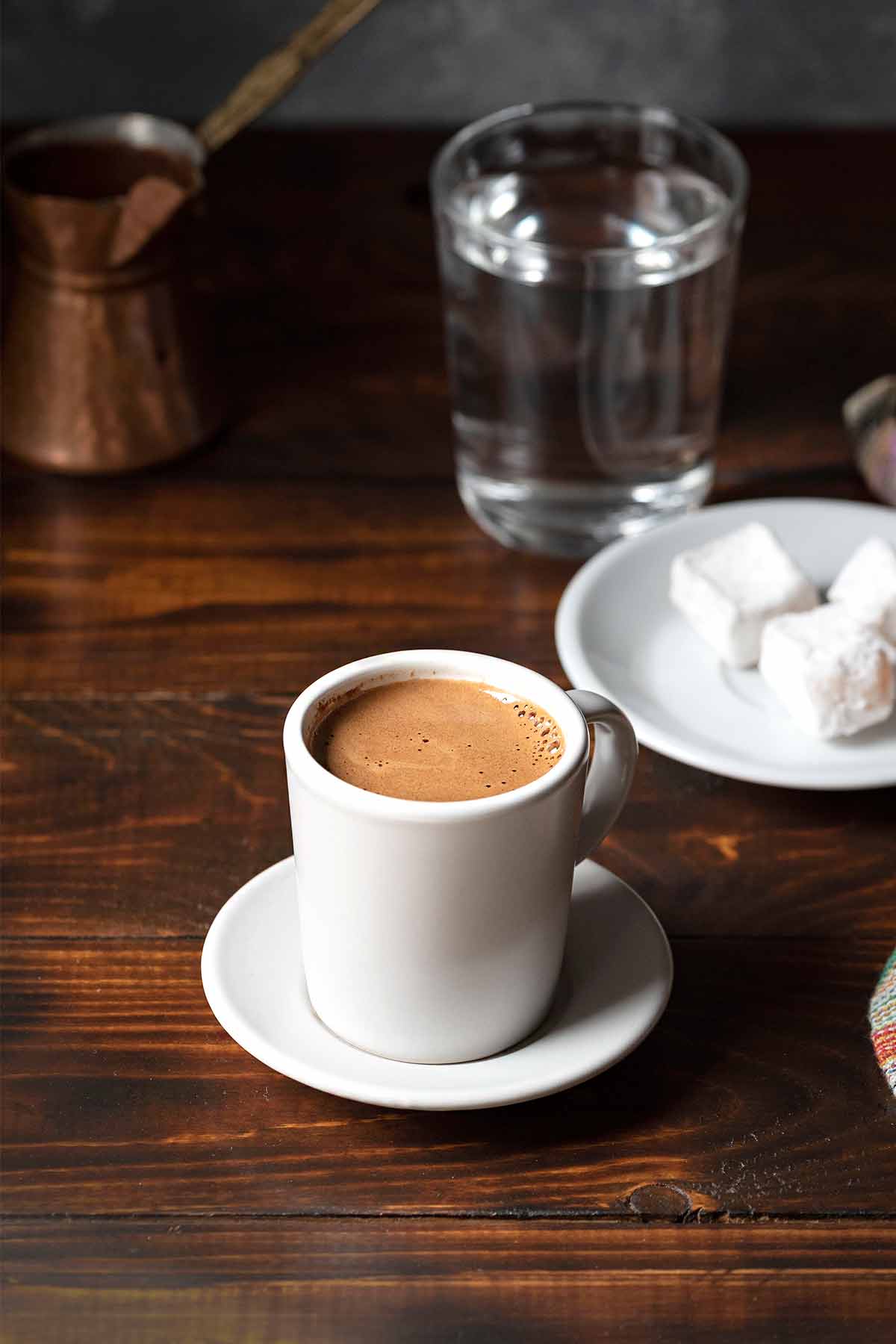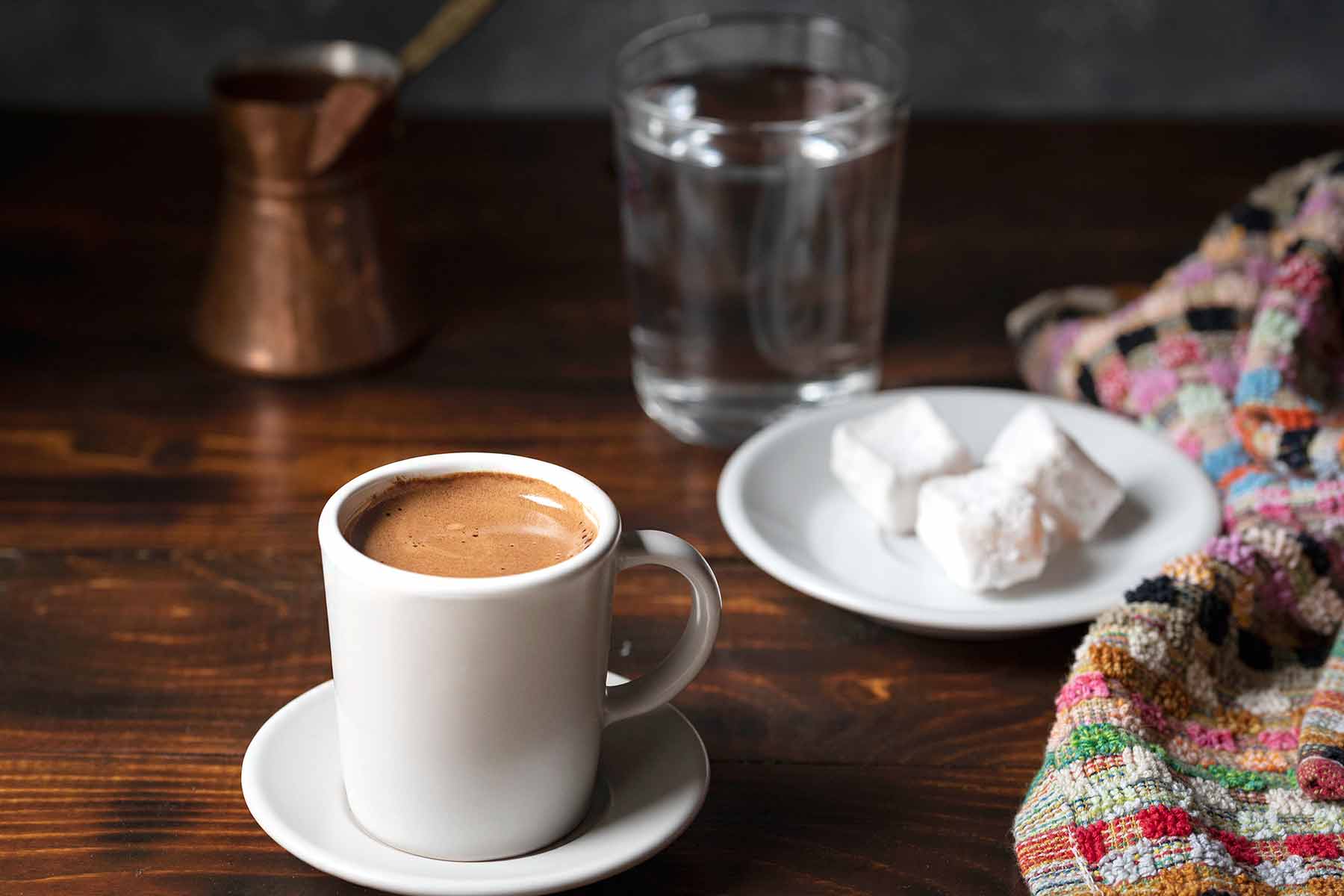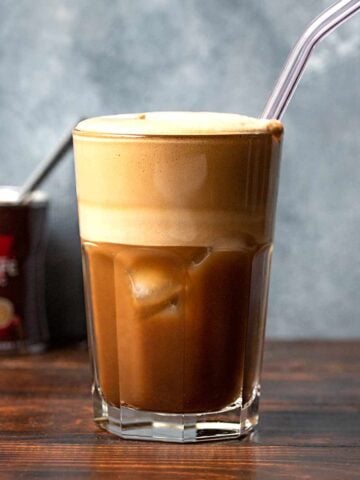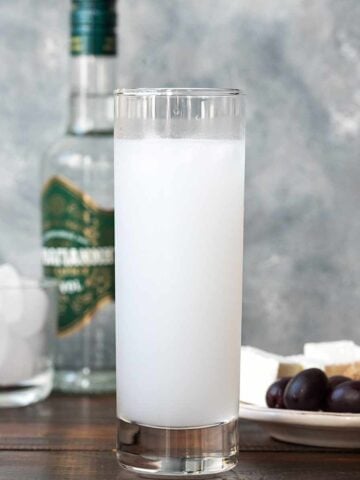Greek coffee is a traditional brew with a rich flavor and thick texture, made from finely ground coffee beans that settle at the bottom of the cup. Curious about how to make Greek coffee like a pro? Just follow my easy, expert tips and bring the authentic taste of Greece right to your home.

The Greek word for coffee is "kafés" (καφές). Greek coffee, known as "Ellinikós kafés" (Ελληνικός καφές), is a traditional brew with a rich flavor, thick consistency, and a special preparation method.
Making a cup of Greek coffee in the morning is more than a habit. It's a ritual. You gently stir the coffee pot (briki) until the coffee grounds dissolve in the water, then patiently wait as it begins to foam. You must stay with the coffee throughout the process, as it can quickly boil over if left unattended. This is a moment that requires patience—it's not the time to rush.
This is the coffee my grandma drank every day, and the one my parents still enjoy each morning. Many of my friends also drink it regularly, though younger generations sometimes opt for an iced coffee such as espresso freddo or capuccino freddo, especially in the summer. The very traditional people usually order this Greek frappe.
😍 Why I love Greek Coffee
Whether you're a coffee enthusiast or looking to connect with Greek tradition, making a cup of Greek coffee is a unique cultural experience that reflects the warm and hospitable nature of Greek society.
Here's what makes it unique:
- Finely Ground Coffee: Coffee beans should be finely ground, almost like powder. The beans are usually medium or dark roasted.
- Special Pot (Briki): It is brewed in a small pot called a briki (hence, it's sometimes referred to as briki coffee). This pot has a long handle and a narrow top.
- Slow Heating: The coffee is heated slowly over low heat, often on a stovetop or over an open flame. In traditional coffee shops, it's prepared on a heated metal plate covered with sand, called a hovoli, which gently heats the coffee.
- Unfiltered: The coffee is not filtered, allowing the grounds to settle at the bottom of the cup. It is customary to stop drinking before reaching the grounds.
- Foam (Kaïmaki): A crucial element of traditional Greek coffee is the foam that forms on top, known as "kaïmaki." It is considered a sign of a well-prepared coffee.

📋 Greek Coffee Ingredients
For this traditional Greek coffee recipe you'll need the following ingredients:

Greek coffee grounds.This Greek style coffee is made from very finely ground Arabica coffee beans. The beans are first roasted to the desired level (usually dark) and then grounded so fine that they resemble the texture of cocoa powder.
The most famous brands of Greek coffee in Greece are Loumidis, Bravo, and Dandali.
Water. Cold or at room temperature.
Sugar (optional).
🥣 Variations
Sweetness Levels: It can be prepared with different levels of sweetness:
- Sketos: No sugar.
- Metrios: Moderately sweet, with equal parts sugar and coffee.
- Glykos: Sweet, with more sugar than coffee.
With tahini (tahinokafes): My grandma, during Lent, used to add some tahini to Greek coffee. Though I love tahini in sweets (like these tahini and olive oil chocolate chunk cookies), I never got to like this type of coffee. If you want to make it, add 1 tablespoon of tahini in a coffee cup and gradually add the coffee while stirring constantly.
With Spices: Occasionally, spices like cardamom are added for extra flavor. However, this is more often used in Arabic countries rather than Greece.
🔪 How to Make Greek Coffee
Follow this easy step by step guide and learn how to prepare Greek coffee like a true Greek:
1. Measure the water: Fill a demitasse cup with water and pour the water into the coffee pot (briki). Use one demitasse cup of water per serving.
2. Add Coffee: Add the coffee and sugar (if using). Stir well until the coffee is dissolved and no lumps remain.
3. Heat Slowly: Place the briki on low heat and heat the coffee slowly. Do not stir once it starts to get warm.
4. Watch for Foam: As the coffee heats, foam (kaïmaki) will form on top. Just before it boils and the foam rises, remove the briki from the heat.
5. Serve: Pour the coffee slowly into demitasse cups, distributing the foam evenly. Allow the coffee grounds to settle before drinking.
Serve with a glass of water and a small sweet, if desired.
Serving: Greek coffee is served in small cups (a.k.a demitasse cups), similar to espresso cups, with capacity of 2 fluid ounces / 60-70 ml.

How to make Greek coffee without a briki
A typical briki resembles the one shown in the photos or video at the end of this post. If you don’t have a traditional briki, you can still make Greek coffee at home using a small metal vessel, like a milk pan or a similar narrow pot. The narrower the vessel, the better for achieving the perfect foam.
It's important to choose the size of the pan based on the number of servings you're making. For one serving, a very small pan or briki is ideal. For 2-3 servings, a larger pan works well. While it’s possible to make a single serving in a larger briki, the kaïmaki (foam) may turn out thinner.
👨🍳 Expert Tips
1. Use finely ground coffee: Greek coffee uses very finely ground coffee beans (almost like powder). The beans are usually medium or dark roasted
2. Always start with cold, fresh water. The quality of water greatly affects the taste of the coffee, so avoid using water that’s been sitting around for a while or water that's heavily chlorinated.
3. Slow Heating: The coffee is heated slowly over low heat. It is often prepared on a stovetop or over an open flame.
4. Stirring: The coffee, water, and sugar are stirred together before heating. Once the foam starts forming, stirring stops to preserve the kaïmaki.
5. Don't let it unattended because it can boil over very quickly.
6. Boiling Point: Greek coffee should never be boiled. It is gently heated to just below boiling to develop the foam and avoid bitterness.
7. Pouring technique: Once ready, start pouring the coffee from low, then lift the coffee pot a little higher and bring it back down to the level of the cup.
8. Let the coffee settle for a moment after brewing. This allows the grounds to remain at the bottom of the cup.
9. Stop drinking before you reach the coffee grounds.
How to drink Greek coffee
Many Greeks like to start their day with a cup of Greek coffee.
In the afternoon it is often served with a cold glass of water and sometimes a small sweet, such as a piece of Turkish delight or a cookie. These Turkish delight filled cookies pair perfectly with Greek coffee but you can also serve it with Italian almond cookies (soft amaretti), the typical Greek (and vegan) sesame cookies (koulourakia) and my favorite, double baked Cretan Kalorizika cookies (almond paximadia).
Cultural Significance
Social Ritual: In Greece, drinking coffee is a social activity, often enjoyed in cafes or homes with friends and family, fostering connection and conversation.
Traditions: Greek coffee is linked to the custom of fortune-telling by reading the coffee grounds left in the cup.
To get a glimpse of your future, leave a small amount of liquid in the cup, swirl it to coat the inside with grounds, then turn it upside down on the saucer. After a few minutes, flip it back up and observe the patterns formed inside. What do you see?
If you find someone skilled in interpreting these patterns, they can reveal your fortune (does this suggest that our fate is already written?)
💭 FAQs
Ordering Greek coffee in Greece is straightforward but knowing the different ways it can be served will help you get exactly what you want. Here’s a quick guide on how to order:
1. Know the Sweetness Levels:
Sketos (σκέτος): No sugar. The coffee is strong and bitter.
Metrios (μέτριος): Medium sweet, with about one teaspoon of sugar per teaspoon of coffee.
Glykos (γλυκός): Sweet, with about two teaspoons of sugar per teaspoon of coffee.
Vari Glykos (βαρύ γλυκός): Sweet with a thick layer of foam (kaimaki) .
2. Specify the Size:
It is typically served in small cups, similar to espresso cups, so there’s usually no need to specify a size. However, you can ask for a diplos (διπλός) if you want a double.
3. Choose Your Add-ons:
Me Gala (με γάλα): With milk. While traditionally Greek coffee is served black, some may prefer a splash of milk.
Choris Gala (χωρίς γάλα): Without milk.
4. Placing the Order. When ordering, you can simply say:
Énan kafé skéto, parakaló (Έναν καφέ σκέτο, παρακαλώ) – A coffee without sugar, please.
Énan kafé métrio, parakaló (Έναν καφέ μέτριο, παρακαλώ) – A medium-sweet coffee, please.
Énan kafé glykó, parakaló (Έναν καφέ γλυκό, παρακαλώ) – A sweet coffee, please.
Greek and Turkish coffee are nearly identical in both preparation and appearance. In Turkey, you’ll order a Turkish coffee, while in Greece, it’s called Greek coffee.
One subtle difference is that in Turkey, the coffee is often allowed to foam more than once, resulting in a stronger brew. This style of coffee is popular in many other Mediterranean and Middle Eastern countries.
According to Wikipedia, the earliest credible evidence of either coffee drinking or knowledge of coffee tree (external link) dates back to the mid-15th century in Yemen's Sufi monasteries. Additionally, PropertyTurkey.com notes that coffee was first introduced either from Yemen or from Syria (external link).
The Turkish coffee pot is called a cezve, while in Greece, it’s known as a briki. Interestingly, this coffee was referred to as Turkish coffee in Greece until the early 1960s. After the persecution of the Greek population in Istanbul, Greeks began calling it Greek coffee as a symbol of national identity.
The briki (or cezve in Turkish) is a tall, thin pot, usually with a conical shape and a long handle that angles upward from the rim.
The narrow neck of the pot helps create a better foam (kaïmaki). If you don’t have a briki, any small, narrow pot will work.
However, keep in mind that if the pot is wide and the quantity of coffee is small, the kaïmaki may not be as thick—which is perfectly fine!
A general guideline is to use 1 heaping teaspoon of coffee per 2-3 ounces of water. Adjust the amount based on how strong or mild you like your coffee.
🍳 More Drinks to Try
🎥Recipe Video
Please note that in this video I'm making a double, hence the two heaped teaspoons of Greek coffee.
📖 Recipe

What is Greek coffee and how to make it (Recipe)
Ingredients
- 2 teaspoons (7 g) finely ground coffee - Greek coffee, (leveled teaspoons)
- ¼ cup (60 g) water, (cold or at room temperature )
- 2 teaspoons (8 g) sugar, (optional, leveled)
Instructions
- Fill a demitasse cup with water and pour the water into the coffee pot (briki). Use one demitasse cup of water per serving.

- Add the coffee and sugar (if using). Stir well until the coffee is dissolved and no lumps remain.

- Place the briki on low heat and heat the coffee slowly. Do not stir once it starts to get warm.

- As the coffee heats, foam (kaïmaki) will form on top. Don't let it unattended because it can boil over very quickly. Just before it boils and the foam rises, remove the briki from the heat.

- Pour the coffee slowly into demitasse cups, distributing the foam evenly. Allow the coffee grounds to settle before drinking.Serve with a glass of water and a small sweet, if desired.

Notes
- Sketos (black): no sugar added.
- Metrios (semi-sweet): one teaspoon sugar per teaspoon coffee.
- Glykos (sweet): two teaspoons sugar per teaspoon coffee.
- Elafris (light): one leveled teaspoon coffee (3.5 grams).














Tony says
I will make it soon!
Makos says
Enjoy!
Ntina says
im greek and i gotta say this is my favourite coffee. This and turkish tea are the best drinks.
John Evans says
I was living in Greece in the late sixties and early seventies and I remember very well that they started calling it Greek coffee just after the Turks invaded Cyprus. They even came out with ads that stated very strongly “We call it Greek.”
Makos says
Yes, from what I know, that's exactly right 🙂
Eleni says
One of the most informative articles I've read about greek coffee, thank you!
Makos says
Thank you so much Eleni!